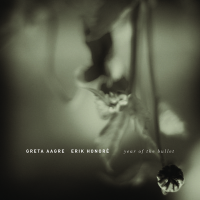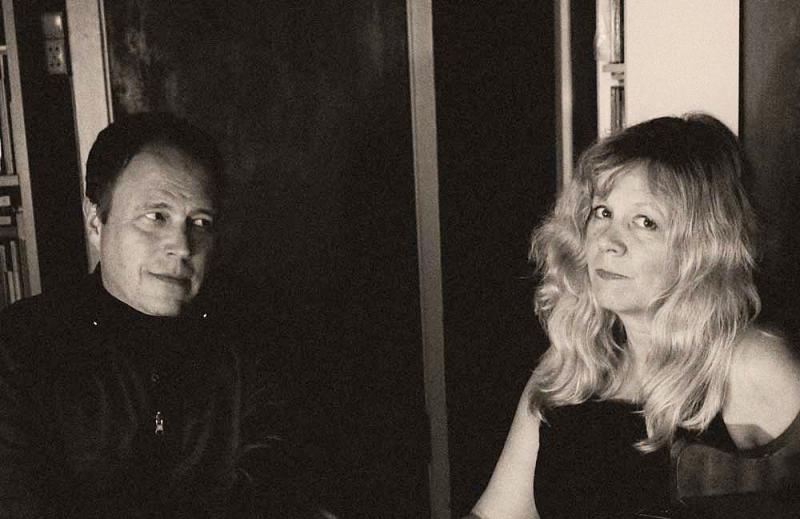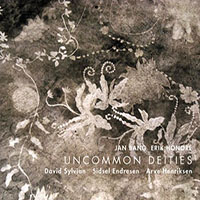Home » Jazz Articles » Interview » Erik Honore: Small Sonic Postcards
Erik Honore: Small Sonic Postcards

Producer/composer Erik Honoré is one of the creators of this new scene, and his work reflects the interaction that is happening between musicians and genres, not only domestically but worldwide. Together with producer/live sampler Jan Bang, he has produced several acclaimed records, including the recent Uncommon Deities (SamadhiSound, 2012)—a collaboration between British singer/songwriter David Sylvian, whose work Bang and Honré have also remixed in the past; Died in The Wool (SamadhiSound, 2011); and albums by singer Sidsel Endresen and trumpeter Arve Henriksen. Honoré and Bang's attitude towards music ultimately resulted in the well-known and ongoing Punkt live remix festival, in Kristiansand, Norway, which has become one of the world's premiere get-togethers of adventurous improvisers. Alongside these projects and collaborations, Honoré has recently released the beguiling, entrancing and dreamlike Year of the Bullet (Jazzland, 2012), a joint effort with vocalist and spouse Greta Aagre.
All About Jazz: Year of the Bullet has an interesting geographical story to it, as it was written and recorded in various locations outside of your native Norway. Please talk about the creative concept behind this record.
Erik Honoré: The idea was to base it mainly on samples that Greta and I collected while traveling. Like collecting small sonic postcards from various places, and then using those as starting points for songs or, in some cases, as textures added to more traditionally composed songs. The thought was that these fragments would work as inspiring building blocks, and hopefully contribute originality to the soundscapes and even serve as emotional triggers for lyrics.
AAJ: How do you establish continuity or connective tissue throughout the record, when bits and pieces come from so many places?
EH: I think this partly happens because we instinctively search for samples that will work musically in various ways, everything from percussive elements to atmospheres or chords, and instinctively we base our choices on earlier experience of what works. And partly it works because when I edit and electronically treat the samples, I make them blend with whatever else is going on. Obviously, editing is a central part of the process. Sometimes we'll keep only tiny fragments of sounds, not recognizable as what they originally were.
 AAJ: To what does the title refer?
AAJ: To what does the title refer? EH: "Years of the Bullet," or "Years of Lead" ("Anni di piombo"), is an Italian expression referring to the seventies, when Italy was plagued by political tension and violence. It's also the title of German director Margarethe von Trotta's movie about this period, and later the expression came to mean "the hard years" in a more general sense. So the title came when we were working on the music in Italy, and in the album context it means simply "the hard year," which is the subject matter of the lyrics.
AAJ: Did you ever think about how the songs would translate live?
EH: Not until we were close to finishing the album, because then the question arose about how to perform the music live. What we chose to do was to take the live process closer to what Jan Bang and I have been doing at the Punkt Festival, the live sampling approach. So I contribute samples, electronics and live sampling of the other musicians, Greta obviously does the vocals, and then we put together a band that we knew would be able to both play songs in a structured manner, and who we could also give open spaces for improvisation. At the Punkt Festival concert we included a soloist, trumpeter Arve Henriksen, who also contributed to the album, and that seemed to work quite well.
AAJ: The press release mentions David Sylvian's contribution at the final stages of this record. What were his contributions here?
EH: David Sylvian is an extremely good listener, who also has helped out on earlier albums, like Arve'sCartography (ECM, 2008), Jan's ... and Poppies from Kandahar (SamadhiSound, 2010). By "a good listener," I mean a person who can comment very clearly on what he hears, and who can pinpoint weaknesses and suggest changes and improvements in a very concrete way. So this was what he did, after first giving Greta and I the confidence to finish the project, something that we really needed at that stage in the process. We needed someone who we respected to say that there was potential, and it had to be someone who wasn't in our immediate family, and who we knew would be honest.
AAJ: You worked with Sylvian closely on his last two records, Died in the Wool, and especially Uncommon Deities. Even prior to this you had the opportunity to work with him on several occasions. How did it evolve into a musical partnership?
EH: First I have to say that I feel immensely privileged that this collaboration has become a reality. Besides Scott Walker, I think David is probably the only musician who I listened to 25 years ago and who is actually doing more interesting work today. Jan and I can thank Nils Petter Molvær for this. It started with David asking Nils if he'd be interested in doing an instrumental version of the track "Mother and Child" for the compilation Camphor (Virgin, 2002). Nils Petter suggested that he could do the remix together with these two guys he knew in Kristiansand, and we did. After that, David returned the favor by contributing spoken word vocals to our album Crime Scenes (Punkt, 2006) and we also got the chance to contribute another remix to his The Good Son vs. The Only Daughter (The Blemish Remixes) (Samadhisound, 2004).

AAJ: Please talk about your involvement on these two records.
EH: Died in the Wool consisted of variations reworked tracks from David's brilliant Manafon (Samadhisound, 2010), plus a couple of new compositions. Here, Jan and I got the chance to contribute more than just remixing one track, and I guess you can say that we were the main "re-makers." together with Japanese contemporary composer Dai Fujikura. And David, of course.
Uncommon Deities (Samadhisound, 2012) was a completely different process. It started by Jan and I commissioning an audio- visual installation from David for the Punkt 2011 festival. As a part of this installation, we invited a group of musicians to improvise in the installation room, and we also commissioned two Norwegian poets, Paal- Helge Haugen and Nils Christian Moe-Repstad, to write texts inspired by the installation concept and its title. Everything that happened in that room was recorded, and David also recorded himself reading the texts in English.
After the festival was over, I sat down with the recordings and some instrumental tracks that Jan and I had been working on for a duo album. Quite soon it seemed that the texts David had recorded worked really well together with the live recordings and the other instrumental tracks. So after making some demos of the material and making sure that David and Jan also saw potential there, we started putting together an entire album. The live contributions from Sidsel Endresen and Arve Henriksen were also very significant, so the album is co-credited them in addition to Jan, me and David. In general, I have to say that I am extremely privileged to be surrounded by these extremely competent and generous musicians.
AAJ: Has Sylvian affected your musical thinking?
EH: Yes, in a very profound way, and from quite an early age. It's no exaggeration to say that Jan and I were extremely inspired by David's three first solo albums when we started working together 25 years ago. At that age, I guess you are searching for something that resonates in you both musically and on a more philosophical level, and I found exactly that in the combination of the words, voice, melodies, arrangements and sonic textures that was to be found on albums like David's Secrets of the Beehive (Virgin, 1987) Also, the combination of composition, improvisation and electronics on those records was, in away, a precursor the evolution on the Norwegian music scene, the "hybrid scene" that we would later be a part of.
AAJ: The Norwegians have emerged as a serious force in the jazz world and electronic music as well, in recent times. Please talk about the music scene in Norway.
 EH: Improvised music has been a strong force in Norwegian music since the sixties, when [saxophonist] Jan Garbarek and others gained an international reputation. For a long time jazz and other music forms lived separate lives, but then there was an evolution in the nineties when improvised music met electronic/club music, most visibly through Bugge Wesseltoft's New Conception of Jazz project and Nils Petter Molvær's work. His ECM album, Khmer, was a huge success, for instance. From there on it seemed that everything was allowed, happily, and suddenly there were all these extremely good young musicians appearing, many of whom had a background in improvised music. But their listening habits were eclectic, and the new technology that allowed for improvisation was also a factor.
EH: Improvised music has been a strong force in Norwegian music since the sixties, when [saxophonist] Jan Garbarek and others gained an international reputation. For a long time jazz and other music forms lived separate lives, but then there was an evolution in the nineties when improvised music met electronic/club music, most visibly through Bugge Wesseltoft's New Conception of Jazz project and Nils Petter Molvær's work. His ECM album, Khmer, was a huge success, for instance. From there on it seemed that everything was allowed, happily, and suddenly there were all these extremely good young musicians appearing, many of whom had a background in improvised music. But their listening habits were eclectic, and the new technology that allowed for improvisation was also a factor.This openness is still the rule, not the exception, and it's this musical mentality Jan and I have built the Punkt Festival concept on. The latest addition to the Norwegian music scene is a number of vocal-based artists, for some reason mainly female, who have combined all these elements to make interesting music. Hanne Hukkelberg is one example. But this especially owes much to Sidsel Endresen's development of the voice as an instrument for more than singing in the traditional sense, so there is a historical line also here.
AAJ: You have been closely associated with Jan Bang through the years. What has your relationship of friendship and work with Bang been like?
EH: We're like an old married couple now, I guess. And it is by far the most important musical relationship I have had. We've developed this way of collaborating, first in the studio and later live, where we can work very intuitively with our various tools, and feed off each others' ideas. When we started it was more like a "synth duo," Jan was the vocalist, I wrote the lyrics and recorded what we did on multi-track cassette machines, and we both played synthesizers and wrote songs. But after we got mixed up with the improv people, we developed other ways of working. Jan was first; he collaborated with Bugge Wesseltoft and Nils Petter Molvær from a very early stage, performing as an improvising live sampler. But I am slowly catching up.
AAJ: How did you come up with the idea of making a festival such as Punkt? Please talk about the festival's concept and how it developed through the years.
EH: Jan and I sat at a café and talked about how we could combine two valuable elements that we knew we had at our disposal: our extensive network of musicians; and our way of working with live sampling/live electronics. So we drew a "family tree" on a napkin, and immediately saw that this musician network was pure gold. Through our Norwegian contacts, musicians that we had worked with either in the studio or live, we could reach most of the artists we wanted to invite if the aim was to create some kind of musical event where the formation of new constellations of musicians and creating new music was the main goal.
At the center of this family tree we had us, and the city of Kristiansand. So we marked this point (punkt) as the center. The venue would have to be the Agder Theatre, which had two stages: One main stage for normal concerts and a second stage well suited to become a "live remix laboratory," where other musicians would sample from and remix the concerts. This we wanted to happen immediately, so that the audience could go there and hear a reinterpretation of the concert they just heard.
This was in 2000, and after that it took us five years to find financing; we needed it to be a high end project technically. But the basic structure was already there, on that napkin.
The first year, in 2005, we had [trumpeter] Jon Hassell as headliner due to his contact with Norwegian guitarist Eivind Aarset, and from then on the project grew in an organic way. As I mentioned earlier, Molvær had connected us with Sylvian. [Bassist] John Paul Jones of Led Zeppelin fame, came to a Punkt event in London and then to Punkt in Kristiansand, the following year he met and played with Supersilent. They still perform together. Jon Hassell and musician/visual artist Russell Mills put us in contact with Brian Eno, who curated the 2012 edition. So almost everything is organized artist-to-artist, a fact that makes it much easier to experiment with new projects and collaborations.
AAJ: What did Eno bring to the festival and how did it fit in with the festival's original design, concept and intentions?
EH: Obviously, Eno is the godfather of many of the genres involved in Punkt, and of the idea of bringing these genres together and working with them with studio tools, or now with technology that earlier was only available in studios. Eno and David Byrne's My Life in the Bush of Ghosts (Sire, 1981) and Eno's work with Jon Hassell are only two examples, there are many others. We first had Eno visit Punkt with his audio-visual installation 77 Milllion Paintings in 2008, and afterwards we asked if he would be interested in curating a whole edition of the festival. He accepted, to our surprise, and this year he brought a number of artists that he personally finds most interesting today. Mainly new or younger artists over a broad genre spectrum, from electronic experimentalists like Ben Frost to pop artist Owen Pallett to improvised standup comedian/musician Reggie Watts.

This experience was very interesting to us, also the aspect of totally letting go of control over the festival program. But we will probably return to curating ourselves next year, at least most of the festival, as this is what we enjoy most. After all, Punkt is an ongoing artistic project to Jan and I, more than a traditional festival.
AAJ: What are some of the most memorable concerts that have happened at Punkt?
EH: On a personal level, I must admit that the highlights have been to perform together with some of the musicians I respect most, like David Sylvian, Jon Hassell, [guitarist] Christian Fennesz and, of course, Sidsel Endresen, Nils Petter Molvær and Arve Henriksen, to name a few. Also because many of these performances have been starting points for further collaboration, recordings and live work. But if you ask our loyal and very knowledgeable audience, they may give you other answers.
AAJ: It seems that the festival has begun travelling around the globe to other locations beyond the mothership festival in Kristiansand.
EH: Yes, we have taken Punkt to London, several cities in Germany, as well as Paris, Barcelona and Tallinn. In these cases, we bring the whole concept and Norwegian musicians, and collaborate with local artists.
AAJ: How have all these experiences influenced your musical thinking and evolution?
EH: The whole Punkt experience has been a very exciting ride, and most importantly it has forced me out of my comfort zone, something that has been very valuable. I am definitely more comfortable in the studio, sitting alone or with Jan and being in control of a small universe that I know, and that responds like I expect it to. But the fact that Punkt and the live remix concept is based on improvisation has taught me a lot. This is knowledge that I then can bring back into the studio environment, or make use of when composing music.
Selected Discography
Greta Aagre/ Erik Honoré, Year of the Bullet (Jazzland, 2012)
Jan Bang/Erik Honoré, Uncommon Deities (SamadhiSound, 2012)
David Sylvian, Died in the Wool: Manafon Variations (SamadhiSound, 2011)
Sidsel Endresen/Jon Hassell, Punkt: Live Remixes Vol. 1 (Jazzland, 2008)
Various Artists, Crime Scenes (Punkt, 2006)
Photo Credit
Page 1: Madli-Liis Parts
All others: Courtesy of Erik Honore
< Previous
New Song
Comments
About Erik Honore
Instrument: Samples / effects
Related Articles | Concerts | Albums | Photos | Similar ToTags
Erik Honore
Interview
Nenad Georgievski
Norway
Oslo
Nils Petter Molvær
Bugge Wesseltoft
Supersilent
Jan Bang
David Sylvian
Sidsel Endresen
Arve Henriksen
Jan Garbarek
Jon Hassell
John Paul Jones
Led Zeppelin
Brian Eno
Christian Fennesz,
For the Love of Jazz
 All About Jazz has been a pillar of jazz since 1995, championing it as an art form and, more importantly, supporting the musicians who create it. Our enduring commitment has made "AAJ" one of the most culturally important websites of its kind, read by hundreds of thousands of fans, musicians and industry figures every month.
All About Jazz has been a pillar of jazz since 1995, championing it as an art form and, more importantly, supporting the musicians who create it. Our enduring commitment has made "AAJ" one of the most culturally important websites of its kind, read by hundreds of thousands of fans, musicians and industry figures every month.























